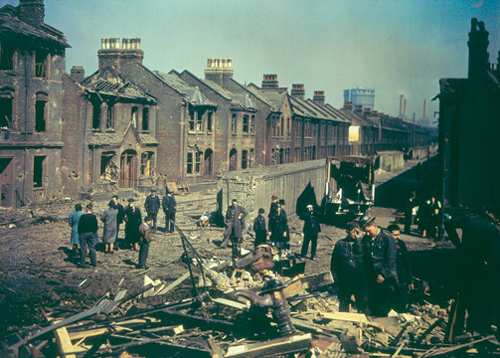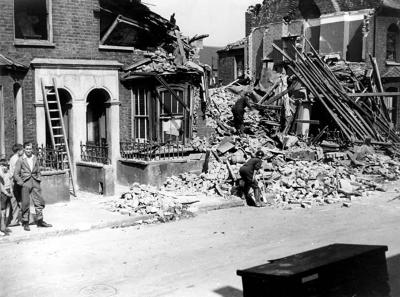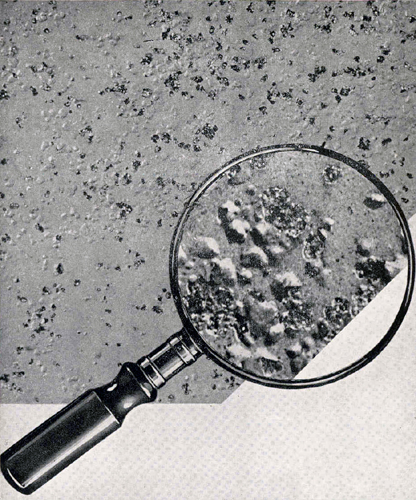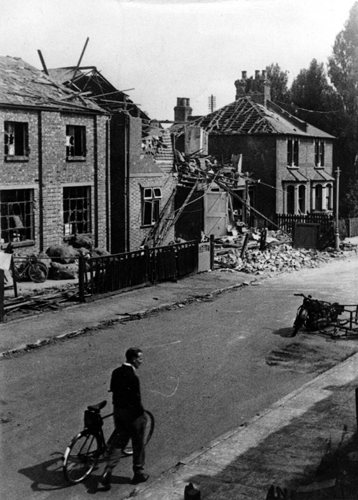
Towards the end of 1941 the Minister of Works established a series of committees to investigate and report on the problems likely to be faced in post-war building. ‘The Painting of Buildings Committee’ was convened in January 1946 by the Paint Research Association with the object of reviewing practice in paint manufacture and painting technique. Amongst other things it was charged with examining the essential needs of buildings during the first three years of peace and the technical properties of paint products.
A booklet was produced in 1944 and this was revised in August 1946.
Part 1 dealt with the three main classes of paints – Oil Paints, Cellulose Paints and Water Paints – in a very clear and succinct manner. Part II looked at The Preparation of Surfaces for Painting and an earlier post considered the problems faced when painting exterior woodwork. In this post the painting of other exterior surfaces is dealt with and some of the problems of redecorating interiors that have been exposed to the elements looked at.
As a potted guide to what was available at the time The Painting of Buildings is excellent. Most of the principles and the techniques still apply, seventy years later.

Exterior Stone, Cement and Brickwork
Painting should only be resorted to in exceptional cases where it is found to be the most economical method of restoring the appearance of damaged or decayed surfaces. If painting is considered necessary, dirt and grime should first be removed by brushing or washing; the use of alkaline cleaning agents, such as soda, should be avoided in this operation.
Where practicable, spraying with water is recommended as an efficient and economical method of cleaning stonework. After cleaning in this way the surface should be allowed to dry and then gone over with a wire brush, and any defects thus revealed made good.
The ‘X’s shows the deteriorated paint film caused by wartime neglect
Discolouration caused by fire will present considerable difficulty, as it is liable to contain tarry mater which will bleed through and discolour the paint. This cannot be readily removed by spraying with water, and the application of a steam jet is preferable, followed by wire brushing. Should extensive restoration of this nature be found necessary, it is advisable to employ one of the firms specializing in this class of work.
The chief difficulty in painting such surfaces will arise from dampness. This may be due to many causes, and in some cases the cause will be difficult to trace. But it may be taken as an axiom that there must be a cause, and the only really satisfactory remedy is to trace and remove it and allow the fabric to dry out thoroughly before repainting it. It is useless to attempt to lock up the moisture with an impervious coat of paint; it is bound to find a way out in warm weather, either by bursting through the paint on the exterior, or by finding its way to the interior surface, where it will probably spoil any decorations there [and cause efflorescence].
Where the surface has been previously painted the preparation should follow the same lines as for woodwork, except that more attention will be necessary where the paint is in general fair condition but has scaled in places; this will often be due to the surface beneath the paint having decayed. In such places the old paint must be removed and the surface made good before repainting.
Interior Plasters (Walls, Etc.)
Here again dampness must be expected, either from damage to the building or from the water necessarily used if extensive repairs to the plaster have been required. It must be realized that the alkaline salts which cause trouble in painting new plaster remain within it after it has dried out and are brought to the surface if the wall is re-wetted. In some cases also the amount of these salts may have been increased by the use of salt water for fighting fires caused by enemy action. The plaster itself may also have become defective and may need making good before decoration. Damp walls must therefore be treated as recommended below for new work and if papered they should be stripped to facilitate drying.
Mould growths will often be found on damp walls, especially if papered or distempered, and, if the growth has penetrated into the plaster, it must be treated with antiseptic solution and kept under observation during the drying-out period, further dressing and antiseptic being given if necessary.
In old buildings the plaster wall surfaces will often be found to have patches of varying porosity owing to local repairs. It is proposed to finish such walls in water paint, the whole surface should first be treated with a coat of priming liquid or other sealer to equalize the porosity, otherwise the water paint will not dry out to a uniform colour.
In order to prevent subsequent flaking, the same treatment is necessary for walls which have been previously decorated with soft distemper or water paint. Where soft distemper has been used it should be washed off as thoroughly s possible. Papered walls, if free from damp and needing only minor repairs, can be stripped, prepared and re-papered, according to the usual practice, if wallpaper is available.
Walls previously finished with flat oil paint, provided they are dry and in sound condition, will only require cleaning. If finished with a gloss paint they must be rubbed down…to provide a key for the new finish. When old and defective plaster has to be made good, or cracks cut out and filled, it is advisable to give the edges of the old plaster a coat of oil paint to assist adhesion by preventing undue absorption of water from the new plaster.
Discoloured ceilings will be abundant after the war owing to rain having penetrated through roofs damaged by enemy action. Such stains are not readily hidden by re-distempering; normally they are dealt with by papering the whole ceiling. In the event of a shortage of the requisite paper immediately after the war, the alternative can be recommended of applying a coat of sharp oil paint1 and re-distempering over this as soon as it is thoroughly dry. If the stains are very dark, it is advisable to use a sharp paint of the greatest possible obliterating power.
Metal Surfaces
Structural Steelwork will often be found after the war to have suffered abnormal corrosion by exposure to fire and water. The normal practice of preparation for protection by painting can be followed, but the necessary thorough cleaning of the surface by removal of rust, etc., will be more important, and more laborious, than ever.
As a general rule these surfaces are prepared for painting by scraping, chipping and wire brushing; the use of a blow lamp for drying and warming the surface will often assist this operation. Angles, edges, rivet holes and rivets should receive special attention. On large surfaces sand-blasting is an effective method of cleaning, and for important work more elaborate methods are practiced such as descaling by oxy-acetylene burners, but these methods are not generally applicable to existing buildings.
Steel Window-Frames and Casements
If rusting has developed extensively the paint should be stripped off entirely and the whole surface cleaned ready for priming. If the paint is in general in good condition, however, the frame should be looked over for local defects, which should be scraped down to bright metal ready for re-priming. Corrosion should be looked for especially at the welded joints, where the paint may have been lifted by the loosening of scale formed during the welding. These joints should be thoroughly cleaned down to bright metal before re-painting, and when priming care must be taken to see that the primer is well worked into every part of the joint. Attention should also be given to the mastic setting of casements.
The zinc coating will often be found to have corroded away leaving the rusted iron surface, which must be cleaned down with wire brush before painting. When the zinc-coating is still intact no priming coat is necessary, and if the surface has been previously painted and is in reasonably good condition it is only necessary to clean down with a stiff fibre brush before repainting. Should any patches of loose paint be found, however, the use of the wire brush is advocated to ensure their thorough removal.
Concluded.
Notes
1 A sharp paint is a thin primer applied to the plaster in order for it to be absorbed and act as a firm base for subsequent coats. It is important that the primer should contain a minimum of oil, being made from paste white lead and a small proportion of paste red lead, thinned with pure turpentine or white spirit to a thin priming consistency. Traditionally this was applied to Keenes’s and Parian cement as soon as it was hard enough to bear the brush, or within twelve hours of it being trowelled.
View Larger Map
















No comments yet. Be the first!